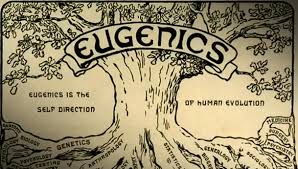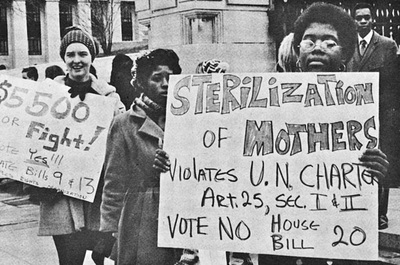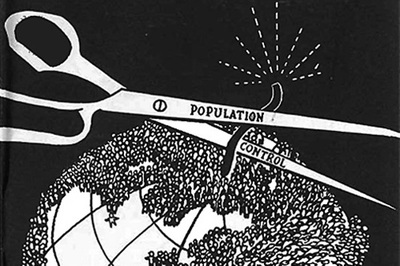"The United States has also had its own conformist and shallow ideals beginning in the 1800s and continuing to as late as the 1990s. Today it is consideed inhumane and by comparison, similar to the beginning of Nazi Germany. What is it? Eugenics -- the sterilization and mistreatment used on those deemed promiscuous, impoverished, and generally “feeble-minded” -- typically those who were mentally ill." - Chloe Xtina |
A SPECIAL THANKS TO MS. K FOR INFORMING ME FURTHER ON THIS SUBJECT
The United States of America has built its mission upon defying conformity and embracing diversity. We have distanced ourselves from fascist principles, acting as the world’s police in cases of terrorist, communist, and tyrannical dictatorships such as those in the Middle East, Vietnam, Korea, the Soviet Union, or Germany.
But the United States has also had its own conformist and shallow ideals beginning in the 1800s and continuing to as late as the 1990s. Today it is considered inhumane and by comparison, similar to the beginning of Nazi Germany. What is it? Eugenics -- the sterilization and mistreatment used on those deemed promiscuous, impoverished, and generally “feeble-minded” -- typically those who were mentally ill.
When I first explored this subject, I expected to find many sources and documents detailing eugenics and it’s potential cover up. But this is simply not the case. There is barely any information on eugenics and it’s not exactly a controversy. There is not a large amount of denial on this subject because many people do not know of it’s existence. There isn’t a complicity either. Eugenics seems to be forgotten because there is no means to record them.
Those who have survived tragedies typically have a voice to share their stories. When Native Americans had their land stripped away from them, they were able to speak out and record their history. When African American slaves underwent cruelty and horrendous treatment, they were able to write and reflect on their experiences. But when the mentally ill and impoverished were cut open and sewn back together again, or beaten, or locked away, there was no opportunity to speak out. Many mentally ill folk did not have the capacity to express themselves and many impoverished people were shamed or kept back from writing their experiences down.
The United States and mental illness has had a long history of turmoil. For centuries, those deemed mentally “unfit” for society were shipped away to institutions where they were physically, emotionally, and sometimes sexually abused. Patients could be starved or be found covered in urine and their own defecation. Neglect was the main medication applied by doctors and nurses.
This, in itself, is something often forgotten as few have recorded first-hand experiences (most mentally ill patients were not able to express themselves and only a handful of people were either journalists who disguised themselves as patients or nurses who were able to see the treatment as inhumane). For many, however, this was something kept unspoken. During the Progressive Era, many reformers attempted to bring this issue to light but education reform and Prohibition outshined prison and mental illness reform.
But here’s something that may seem outlandish:
This wasn’t solely a Victorian era dilemma. This continued to the early 1990s.
And this is thanks to a little movement called “Eugenics”.
The United States of America has built its mission upon defying conformity and embracing diversity. We have distanced ourselves from fascist principles, acting as the world’s police in cases of terrorist, communist, and tyrannical dictatorships such as those in the Middle East, Vietnam, Korea, the Soviet Union, or Germany.
But the United States has also had its own conformist and shallow ideals beginning in the 1800s and continuing to as late as the 1990s. Today it is considered inhumane and by comparison, similar to the beginning of Nazi Germany. What is it? Eugenics -- the sterilization and mistreatment used on those deemed promiscuous, impoverished, and generally “feeble-minded” -- typically those who were mentally ill.
When I first explored this subject, I expected to find many sources and documents detailing eugenics and it’s potential cover up. But this is simply not the case. There is barely any information on eugenics and it’s not exactly a controversy. There is not a large amount of denial on this subject because many people do not know of it’s existence. There isn’t a complicity either. Eugenics seems to be forgotten because there is no means to record them.
Those who have survived tragedies typically have a voice to share their stories. When Native Americans had their land stripped away from them, they were able to speak out and record their history. When African American slaves underwent cruelty and horrendous treatment, they were able to write and reflect on their experiences. But when the mentally ill and impoverished were cut open and sewn back together again, or beaten, or locked away, there was no opportunity to speak out. Many mentally ill folk did not have the capacity to express themselves and many impoverished people were shamed or kept back from writing their experiences down.
The United States and mental illness has had a long history of turmoil. For centuries, those deemed mentally “unfit” for society were shipped away to institutions where they were physically, emotionally, and sometimes sexually abused. Patients could be starved or be found covered in urine and their own defecation. Neglect was the main medication applied by doctors and nurses.
This, in itself, is something often forgotten as few have recorded first-hand experiences (most mentally ill patients were not able to express themselves and only a handful of people were either journalists who disguised themselves as patients or nurses who were able to see the treatment as inhumane). For many, however, this was something kept unspoken. During the Progressive Era, many reformers attempted to bring this issue to light but education reform and Prohibition outshined prison and mental illness reform.
But here’s something that may seem outlandish:
This wasn’t solely a Victorian era dilemma. This continued to the early 1990s.
And this is thanks to a little movement called “Eugenics”.
Eugenics is often attributed to Adolf Hitler’s “ubermensch” (translated to “superman”), someone a part of a superior race -- in the case of the Nazi’s, an aryan person. Universally, Eugenics is a belief system that attempts to improve the genetic makeup of the human race. The United States adopted this in the early 1900s. It became very apparent at the beginning of World War II but perhaps was downplayed so that the American movement was not associated with the Nazi movement and the United States remained idealistic as the world’s leading free nation.
The American Eugenics movement sought to sterilize or institutionalize anyone who was deemed “feebleminded” -- often those who were seen as sexually promiscuous or those who were impoverished (a lot of times these were teenage girls or racial minorities). Mentally ill people were sterilized as well and had been since the early 1800s. Anyone seen remotely “disturbed” were sent away during this time -- often times those who had down-syndrome (who are now seen as able to function in society since the late 1980s) or had other birth defects (my great-uncle was sent to a facility after being dropped on the head as a baby).
The reason that those deemed “feebleminded” were forced into sterilization was due to the fear that their offspring would have the same faults and would continue to live in society, repopulating with those deemed “normal”.
Although the movement lost its momentum in during the war, it quietly continued in forms of both sterilization and institutionalization until the early 1990s. It occurred typically in the South and among racial minorities in terms of sterilization. In terms of institutionalization, people with down-syndrome were shipped away and neglected by their families until reformers called for an end in the late 1980s.
Mental illness facilities, although not as horrid as centuries before, still treated patients as if they were not fit to become members of society. There continued to be embarrassment and ignorance within family members toward their institutionalized relatives.
It then became apparent that mental illness facilities should only be relative for cases of potential self-harm, threatening behavior, or being unable to care for themselves. The Eugenics Movement has since ended.
Finally, it is widely accepted that the mentally ill themselves are people regardless and it is taboo that minorities are “feebleminded”. However, we must remember it was not that long ago that we had completely reversed beliefs.
Here are some resources to keep you further informed:
http://www.nature.com/scitable/forums/genetics-generation/america-s-hidden-history-the-eugenics-movement-123919444
http://www.dualdiagnosis.org/mental-health-and-addiction/history/
http://www.eugenicsarchive.org/eugenics/topics_fs.pl?theme=9
http://www.globaldownsyndrome.org/about-down-syndrome/the-story-of-two-syndromes/
http://www.globaldownsyndrome.org/about-down-syndrome/history-of-down-syndrome/down-syndrome-human-and-civil-rights-timeline/
https://www.youtube.com/watch?v=Nshj9rCTPdE





